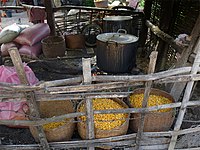
Muang Sing
Muang Sing (Mueang Sing) (Lao: ເມືອງສີງ, Lao pronunciation: [mɯ́a̯ŋ sǐŋ]) is a small town and district (muang) in Luang Namtha Province, northwestern Laos, about 60 kilometres northwest of the town of Luang Namtha and 360 kilometres northwest of Vientiane.[1][2][3] It lies very close to the border with Yunnan, China, surrounded by mountains and rivers. Historically, Muang Sing has been a major producer of opium and still has problems with drugs and smuggling, due to its proximity to China and Myanmar.
Muang Sing
ເມືອງສີງMuang Sing
There are over nine minority groups in Muang Sing District. As of 2000 there were some 68 Akha villages, 26 Tai Lue villages, five Tai Neua villages, five Yao villages, three Hmong villages and one Tai Dam village in the district.[6] These ethnic groups are classified in terms of elevation such as Lao lum (lowland Lao) and Lao sung (highland Lao).[6] There are also many ethnic Yunnanese people in the area, mainly traders. The Akha which comprise about 45%, speak Tibeto-Burman languages and are mostly found in the rural parts of the district, especially the hills, and the Tai Lu, 30% of the people, form the largest ethnic group living in the main town.[11]
Economy[edit]
The district has a history of drug trading from at least French colonial times as it is a key transit point for smuggling, lying on a road (known as Opium Road) which connects to Burma and to the Chinese town of Zaho, passing through Oudomxay and Botom. The area is part of what is known as the Golden Triangle,[12] one of the world's most productive and notorious areas for drugs and smuggling. A number of opium dens are known to operate in the area and in 2000, Laotian police confiscated 398,000 methamphetamine pills in a truck.[3][13] Since 1992, political difficulties and territorial disputes between Laos and China has also led to increased trafficking of goods across the border including beer, cigarettes, fruit, rice, batteries and clothes.[5] Tourism has also begun in Muang Sing, with both wealthy travellers and young backpackers, the main focus being to visit the remote Akha villages.[14]
The principal temple of some 20 in Muang Sing is the Wat Sing Jai or Wat Xieng Jai, behind the Muangsing Guest House. The monastery, painted in hues reminiscent of the Caribbean, has a museum, but because its items are of high local value, it is closed to visitors for fear of theft.[1] Another major temple is the Wat Namkeo. The wihan in the town are typically multi-tired roofed buildings typical of northern Laos, but most houses have corrugated metal roofs and wooden beams, reflecting a lack of wealth in the area.[8] The Buddhas, however, are golden, and typically have large long earlobes, commonly seen in Xishuangbanna, China and Shan State of Burma.[8]
On the main market in Muang Sing Yunnanese traders sell goods such as Western clothing, fake sports clothing and gear, electrical and household appliances and cooking oil, and local ethnic people sell mostly vegetables, fruits, herbs and spices.[1] Due to the increase in tourism in recent years, a number of small new hotels and restaurants have sprung up in the town, including the Phou Iu Guest House and Restaurant, built in 2003, Charmpathong, Muangsing Guesthouse, Danneua, Phou Lu, Saengdeuang and Singcharean, the largest hotel as of 2002 with 22 rooms[15][11] Muang Sing's first eco-tourist resort was Adima, a hotel consisting of bamboo bungalows, about 8 kilometres north of the town.[15]
Most of the houses in the district are built in the traditional style with wooden beams, raised off of the ground on stilts and covered with thatched/bamboo roofs. The locals, especially the Tam Dao and Tai Lue people, are adept at silk and cotton weaving. The Tam Dao weave sins (traditional Lao skirts), scarves and works of art. The Tai Lue cotton weavers in villages such as Nong Boua and Xieng Yun make dyes consisting of a blend of leaves, flowers, insects and wood and weave traditional cotton textiles.[16] The women of the Akha ethnic group are also skilled at making heavy indigo-dyed cotton fabric, generally used to make bags, clothes and other souvenirs to sell to tourists.[16] The Yao people are noted in particular for their needlework and embroidery and are skilled in making trousers, tunics and turbans. Between November and January, they produce a durable bamboo paper which is dried and later used as paper, primarily for religious purposes.[16] The Hmong also manufacture embroidered clothing, bags and blankets for special ceremonies and festivals.[16] The locals manufacture banners with bright colors such as orange, pink, blue, green, red and purple and often feature animals, humans and with Buddhist themes.[8] The banners are typically 2 or 3 metres in length and 1 ft in diameter and are often adorned with beads, sequins, tassels, metal foil and paper.[8]
A notable local dish is Khao soi (English: "rice cut"), a Lao noodle soup, made by slicing a rice pancake into strips with scissors. Khao soi noodles are particularly popular among the Tai Lue and Tai Neua villagers, especially in the village of Ban Siliheung.[17] The alcoholic drink Lao Lao is a staple of the locals, a rice beer made from fermenting and distilling rice in large steel drums. Ban Koum, four kilometres southeast of the main town on the road to Luang Namtha is noted for its whisky production.[17]
Since the 1980s, there has been a marked revival of Buddhism in Muang Sing and as of 2000, there was reported to be 21 temples in the district, most of them relatively new.[5] In January 1996 Khuba Bunchum (1965-), a Buddhist teacher from Bangsa, built two stupas in the area.[5]















